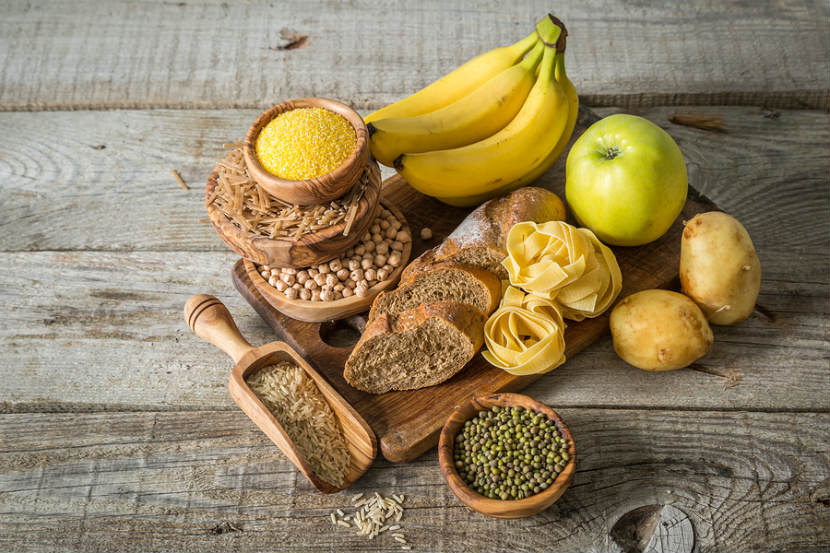
If you have diabetes, you can still eat foods that contain carbohydrates. Having diabetes means managing the type and amount of carbohydrates you eat. Read on to find out more about carbohydrates and how they affect people with diabetes.
What is a carbohydrate?
A carbohydrate is a nutrient that provides you with calories (energy) and affects your blood sugar (or blood glucose). The following foods contain carbohydrates:
-
Vegetables and Fruit: Starchy vegetables like potatoes, cassava, yams, corn and peas have higher amounts of carbohydrates. Other vegetables have small amounts of carbohydrates in them. All fruit including fresh, frozen, canned, dried and fruit juice contain carbohydrates.
-
Grains: Rice, pasta, breads, crackers, quinoa, oats and cereal are examples of grains that contain carbohydrates.
-
Protein foods: Beans, lentils, dried peas, milk, yogurt, plant-based beverages contain carbohydrates.
Carbohydrates are also found in snack foods like baked goods, ice cream, chocolate, pop, candy, pretzels, tortillas and chips.
Note: Protein and fat do not contain carbohydrates.
How do carbohydrates affect people with diabetes?
When we eat, carbohydrates in food are digested and turned into sugar or glucose. Glucose then gets absorbed into our blood. The glucose goes from our blood into our cells with help from a hormone called insulin (insulin is made in the pancreas). We then use the glucose in our cells for energy. If you have Type 2 diabetes, your body cannot move glucose from your blood into your cells well. This may happen because:
When glucose cannot go into your cells, it stays in the blood causing high blood glucose levels or “high blood sugar.” Not managing high blood glucose can cause health problems like high blood pressure, eye disease and kidney disease.
Carbohydrate breakdown: What are sugars, starch and fibre?
Sugars, starch and fibre are the three categories of carbohydrates. Sugars and starch raise your blood glucose levels and fibre does not.
Sugars
Sugars make food sweet. Sugars can be naturally occurring, such as in milk and fruit. Or sugars can be added by a food manufacturer, like in candy or cake. Honey, molasses, maple syrup and white or brown sugar are also examples of sugars. It’s wise to cut back on added sugar. It should make up no more than 10 percent of your total calories. In a 2000 calorie diet, 10 percent of calories from sugar is equal to 50 grams (or about 3 ½ tablespoons) of sugar per day. More than 10 percent of calories from sugar can increase blood glucose levels in some people. Check the food label of your favourite foods to find out how much sugar is added. Sugar is listed under fibre on the food label. You can also check the ingredient list for sources of sugar. For more on sugar, read what you need to know about sugar.
Starches
Starches are the type of carbohydrate found in grains (rice, pasta, breads, crackers, cereal and so on), some vegetables (potatoes, yams, cassava, corn) and legumes (beans, lentils and dried peas). Starches cause blood glucose levels to rise, but it doesn’t mean you shouldn’t eat them. The right amount of carbohydrate for you depends on your body size, medications and physical activity levels. You can use a tool like the glycemic index to figure out which carbohydrate-containing foods raise blood glucose more slowly.
Fibre
Fibre does not raise your blood glucose. There are two types of fibre - insoluble and soluble. For people with diabetes, soluble fibre may help manage blood glucose. It can also help manage blood cholesterol levels. This is important since high cholesterol is a risk factor for developing diabetes. Soluble fibre is found in:
-
Barley
-
Fruits, like apples and pears
-
Legumes like beans, lentils and peas
-
Oats
-
Psyllium (found in some cereals)
-
Vegetables like eggplant and okra
Insoluble fibre helps promote regularity and a healthy digestive system. Read more about fibre and how much you need here. If you are not used to eating fibre, add high fibre foods slowly and drink lots of water. This will help prevent upset stomach, gas and bloating.
Helpful hint: When reading food labels to find high fibre foods, look for 4 grams or more of fibre per serving!
How can a Dietitian Help?
A dietitian will advise you on how many carbohydrates you should eat at each meal and snack to help manage your blood sugars. They will help you read food labels for carbohydrates and help you incorporate your favourite foods into your eating plan. Your dietitian will also help you balance your meals with protein and fibre, and troubleshoot any spikes in blood sugar you may have throughout the day. Connect with a dietitian today!
Bottom line
If you have diabetes, pay special attention to the type and amount of carbohydrate you eat. Foods can have different types of carbohydrates, such as sugar, starch and fibre. The right amount and type of carbohydrate for you depends on your body size, medications and physical activity levels. Work with a dietitian to figure out a meal plan that balances carbohydrate foods and keeps your blood sugar consistent.
You may also be interested in:
Getting to Know the Glycemic Index
Diabetes and the Health Benefits of Fibre
Take the Diabetes Quiz
Diabetes Menu Plan
This article was written and reviewed by dietitians from Dietitians of Canada. The advice in this article is intended as general information and should not replace advice given by your dietitian or healthcare provider.
Last Update – January 14, 2023